| 11/2/2024: Election 2024: The Final Hours [RightDataUSA] | |||||||||||||||||||||||||||

Photo credit: CNN
With just a few more hours until the 2024 election campaign season mercifully concludes, we are on track for one of the closest elections in U.S. presidential history if the polls can be believed. But some folks are not so sure about that, and are thinking in terms of "waves" and "landslides" that will deliver not just the White House but also the U.S. House and Senate. For example (just from the past few days):
But also:
These polar-opposite worldviews are hardly unexpected; the fragile snowflakes on both sides (there are far more on the left, but no shortage on the right either) need to be constantly reassured that things are going their way, no matter what "lies" they may hear which say otherwise. Pay no attention to the man behind the curtain and believe everything we tell you, they say. Well, somebody is lying, and somebody is going to be crushingly disappointed on November 6th or whenever the vote-counting finally ceases. 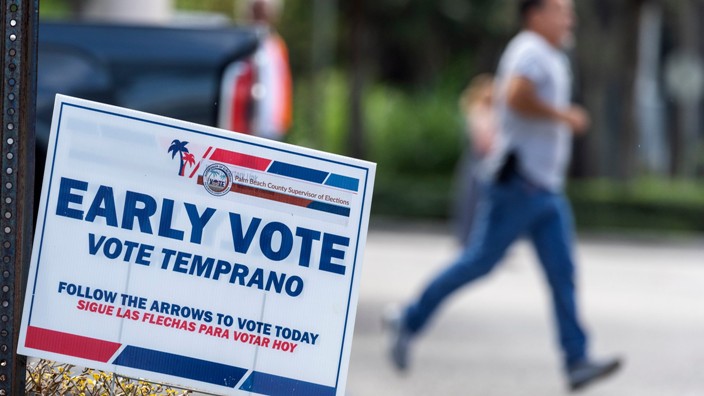
Photo credit: Palm Beach Post
Early Voting
In a nation as closely divided as this one, it appears that the potential for a "wave" that would sweep over the presidency, the Senate and the House is minimal. But it's not impossible. We'll say this much: if there is any kind of wave, it's probably going to be the kind we don't want to see. Republicans routinely underestimate the amount of hatred Democrats are capable of, and hatred is an excellent motivation for voting. 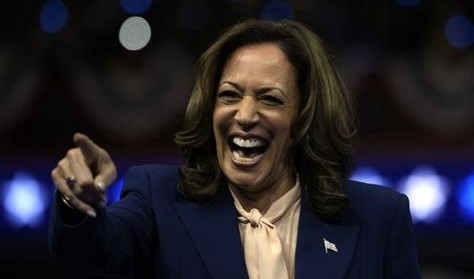
Photo credit: Twitchy.com
The 2024 Presidential Election:
If this series of miniscule margins that generally favor Donald Trump -- ALL of which are within the margin of sampling error -- carry over to the actual vote counts, then Trump will prevail in the Electoral College by the count of 287 to 251 assuming all other states go as expected. Which means that the "Keystone" to the election is the state of Pennsylvania -- as we noted long ago and wrote about in considerable detail; it is tremendously likely that whoever wins PA wins the election. There are a couple of things to keep in mind about all of these pollsters who are showing exceedingly close races in several states at the presidential level, and in other races as well:
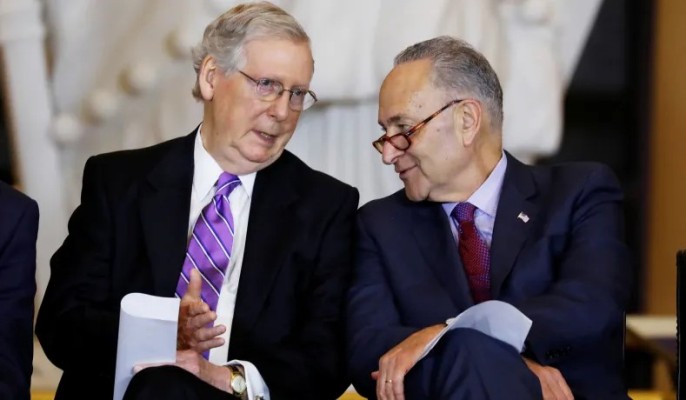
Photo credit: National Review
The Senate:
The potential bad news comes from Florida, Texas and even rock-solid crimson, burgundy, maroon Nebraska, where an "independent" phony-moderate candidate is supposedly within striking distance of squishy Republican incumbent Deb Fischer according to the far-left New York Times and the liberal candidate's own polls; all other polls forecast a normal Nebraska outcome. The Democrats did not even field a candidate here -- aside from the one who is calling himself an independent. Republicans are likely to hold all three of those seats. The Rats are flooding Florida and Texas with $$$ but it would still be quite an upset if Ted Cruz or Rick Scott were to lose; some now classify the TX race as a tossup. The saving grace for these two Republicans could be the laughably poor quality of their liberal Democrat opponents. But the usual Democrat formula of (money + lies + hate) = victory certainly could work. There's one important ingredient we left out of that equation, which helps Democrats greatly when money + lies + hate isn't quite sufficient. That ingredient is normally not added until after the votes are cast. 
Photo credit: The Hill
It's not necessarily about voters actually supporting the dim-bulb Democrats in FL & TX; it's more about voting against the Republicans. Neither Scott nor Cruz are popular with anything more than the tiniest majority of the electorate in their states. Trump is going to win Florida and Texas and even though casual observers will be surprised to hear that a coattail effect might be required for Scott and Cruz, that very well may be the case. We'll say they both pull it out in the end.
There are also lunatic fringe pipe dreams regarding Republican pickups in Maryland and Virginia. However the GOP has zero chance in Maryland and at most a 10% chance in the Virginia Senate race. But those other six states are going to be close, to one degree or another. Ohio and Wisconsin are the most likely pickups; Arizona (one outlier poll aside) and Nevada are the least likely. Pennsylvania and Michigan currently look improbable too. In any event, this is all gravy for the Republicans. They have nothing to lose in these states and everything to gain. The probability, however, is that they will gain nothing, or at most one. But it would take only a very slight shift to the right, and suddenly it could be another +2! Or more! All Senate polls are close in these marginal states and, on average, they all show the Republican losing. Final score: The most likely outcome is a net gain of 2 or perhaps 3 seats for the GOP, which means the breakdown will be 51-49 or 52-48 in the Republicans' favor starting in 2025. It may be assumed that any "wave", however low the probability is that one occurs, can only push things further in the Republican direction. But don't completely discount the possibility of an unpleasant surprise in Texas or Florida. Worst case scenario: the Senate stays 51-49 Democrat, and that is not terribly likely. 
Photo credit: Fox News
As far as the likely outcome: as we have noted on numerous occasions, having only 51 or 52 seats is not satisfactory to give the GOP anything but nominal control. There are at least two Republican senators -- Lisa Murkowski (Alaska) and Susan Collins (Maine) -- who are for all intents and purposes Democrats. They can continue to sabotage GOP efforts from within as the leadership would prefer; they can drop the charade and become Democrats; or they can go the "independent" route. Regardless, GOP "control" of the Senate will be largely illusory in every way aside from perhaps mathematics.
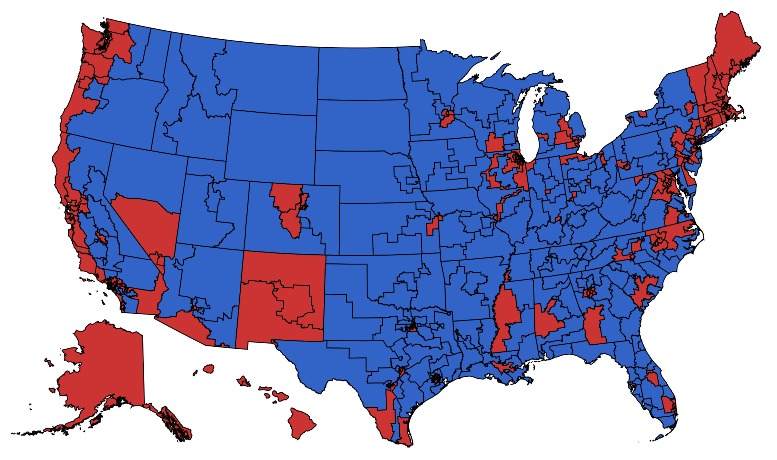
Current U.S. House breakdown by district (Map created using mapchart.net)
The House:
Democrats could get the +4 they need in New York and California alone. Republican freshmen (and some incumbents) won numerous close -- fluke -- elections in 2022 and a large portion of those outcomes are highly likely to be reversed. One already has been reversed (NY-3, Santos) in a special election. There are as many as five vulnerable GOP freshmen in New York. Two of the five (Brandon Williams, Anthony D'Esposito) appear to be near-certain losses. Two others (Marc Molinaro, Mike Lawler) are tossups at best. Numerous Republicans are on the hot seat in the Land of Fruits and Nuts. Endangered incumbents include John Duarte, David Valadao, Mike Garcia, Michelle Steele and Ken Calvert. It will be no surprise if at least two or three of those lose. Don't bother staying up late on election night to find out. California gives itself 30 days to count votes in order to facilitate "ballot harvesting" after election day. Thirty days apparently wasn't enough time for California Democrats in 2022; don't expect the same results in 2024. Unless an endangered California incumbent is solidly ahead prior to Ballot Harvesting Month, then he/she doesn't have much of a prayer of remaining in Congress. Republicans will pick up 3 seats in North Carolina due to the removal of the 2020/2022 illegal Democrat gerrymander. Republicans will lose 2 seats (one in Alabama, one in Louisiana) due to the impact of racist court rulings which have demanded that a White Republican be replaced by a black Democrat in both instances. Elsewhere, the list of likely ("likely" = "maybe a 50.1% chance" so don't get too excited) GOP pickups is a short one:
The list of likely GOP losses is longer, even without including the five endangered Californians:
Neither of these lists is exhaustive. For a wider range of possible House flips, read our report from a couple weeks ago. If there is any kind of movement off-center, one list or the other will expand. Based on all of the above expectations, the final outcome in the House is going to be exceedingly close. Republicans will need at least a small swing to the right in many districts in order to simply retain what they already possess; that swing is hardly a certainty. The likeliest outcome is that the GOP suffers a net loss of 2 to 8 seats. The results from 2022 in California and New York are what gave the Republicans the House during this past term; the results from those states in 2024 will be the ones which are primarily responsible for giving Democrats control beginning in 2025, if the House does in fact flip. State legislatures: Nearly all states are having legislative elections this year. Those elections are well under the radar as compared to the U.S. House, Senate and presidency, but they are hardly unimportant. In most places, partisan control of a state House or state Senate is not in much doubt. However there are a handful of states -- many of the same ones which are tossups at other levels too -- in which control of a state legislative body could easily flip from one party to the other. The ones that are most flippable include: Alaska: Both the House and especially the Senate are close, but it almost doesn't matter because even when the GOP has the numbers (as they always do) the liberal-RINO wing of the party conspires with liberal Democrats to form a "coalition" which ensures that conservative legislators are on the outside, and powerless. The House currently consists of 21 R, 13 D and 6 independents; the Senate has 11 R and 9 D -- with 8 Republicans and all 9 Democrats working together to seize control and exclude three conservative Republicans. Arizona: The Rats need ONE House seat (there are 31 R and 29 D) and ONE Senate seat (16 R, 14 D) to move from minority status into a tie. Obviously that means they need +2 to take full control of the state government. Michigan: Dems flipped both houses in 2022. Michigan Republicans are in an identical position to Arizona Democrats: +1 to tie, +2 to win. The House is 56 D, 54 R; the Senate is 20 D, 18 R. Neither Arizona nor Michigan are exactly known for election integrity lately, so temper your expectations accordingly. Minnesota: Republicans need a net gain of 1 seat in the Senate (34 D, 33 R) to win back what they lost control of in 2022. It will take a small wave (R+4) to get the House. New Hampshire: In a state where practically every neighborhood has its own representative (there are 400 seats in the House of this tiny state) things often fluctuate wildly. If they fluctuate just slightly to the left, Rats will get the House. The current breakdown is 201 R, 196 D, 3 I. Republicans have nominal control of the state Senate (14 R, 10 D). Pennsylvania: Could cause the fragile types to ingest a ton of copium next week if Cackles wins, Casey is re-elected, Perry loses, etc. Then add the Democrats going +3 and taking the state Senate (current breakdown: 28 R, 22 D) and by doing so seizing 100% control of PA government. The GOP is fighting hard and may avert disaster, at least in the state Senate. The Rats currently lead 102-101 in the state House and on a good election night the Republicans will take it back. On a bad night they won't. Wisconsin: The GOP has large majorities in both houses of the legislature.... today. In 2025, they won't. A Democrat gerrymander has been put in place for 2024 and when the votes are counted the Wisconsin House and Senate are going to look a lot like Pennsylvania's or Michigan's -- tossups all the way around. The Wisconsin GOP needs a good election night at all levels. Currently the splits are 22 R, 11 D in the Senate and 64 R, 35 D in the House. Enjoy it while you still can, Wisconsin Republicans. Tags:
2024
House
Senate
Presidency
Hope we're wrong about the House
| |||||||||||||||||||||||||||
| 10/17/2024: 2024 Election Analysis: Will Republicans Hold the House? [RightDataUSA] | |||||||||||||||||||||||||||

Current U.S. House breakdown by district (Map created using mapchart.net)
1. Competitiveness
That last one is a biggie, but the others are also important. Regarding the suitability of the candidates: Democrats always try to run the most liberal candidates possible in House races, but in a marginal district they must (with the help of their army of media allies) attempt to disguise their nominee as a "moderate" because they understand that most voters in a marginal district would find an in-your-face liberal nutbucket to be repugnant. Once elected, Democrat "moderates" normally march in goose-step with their liberal colleagues. Even when narrowly in the minority as is the case today in the House, Democrats voting as a united bloc is nearly always sufficient to thwart any unwanted legislation. This happens because there are always enough liberal Republicans in the party's "big tent" to cross over and assist the Democrats whenever the Republican establishment (GOPe) desires for that to occur. Sometimes, particularly on legislation which has no chance of passing the Senate or being signed into law, the Democrat puppetmasters will permit their most vulnerable House members to temporarily leave the plantation and cast a non-liberal vote. Which they can then highlight to the voters back home as a sign of their alleged "independence" when re-election time rolls around. Of course there is no real independence; they vote as they are told to -- always. Those who control the Republican party (and especially its purse strings) also seek to run the most liberal candidates possible in House races -- even in solid Republican districts -- because the GOPe finds anyone who is even remotely conservative to be repugnant. On this topic, the leadership of both parties are in agreement. Occasionally, the GOPe is correct in running a moderate-liberal if the nature of the district is inappropriate for a nominee who is perceived as being too far to the right. Based on the above criteria, we have identified 62 districts which should be competitive this year. This list is not substantially different from the one we published over a year and a half ago, but the data associated with these districts is now up-to-date. In addition to the potential flippers, there's also one district in Washington which features two Republicans and zero Democrats running; the incumbent Republican is a Trump-hating impeachment RINO while the challenger is a solid conservative. If an upset should occur there it won't count as a GOP pickup since they already hold that seat, but it would be a welcome development nonetheless. 2. Background After the 2022 elections, Republicans controlled the House by the margin of 222-213. Since that time there have been 8 special elections held to replace representatives who retired or died. Seven of those 8 were won by the same party which originally held the seat. The lone exception occurred in New York in February when Democrats won the special election in NY-3 to replace conservative Republican George ("Miss Me Yet?") Santos. That election was necessitated when the Stupid Party decided to expel Santos from Congress in December, 2023 for allegedly being so corrupt that he might as well have been a Democrat. But he voted like a conservative which, come to think of it, probably didn't help his case with the party leadership. The have been three other resignations or deaths for which special elections have not yet been held (or will not be held), and the GOP currently has a 220-212 advantage in the House. Because two of the three vacancies exist in solid Democrat districts (NJ-9, TX-18) which will be easily retained in November, the Democrats effectively have 214 seats going into the election which means they require a net gain of merely 4 seats to seize control. 3. Belated Redistricting Congressional redistricting -- the redrawing of U.S. House district lines -- took place in all states prior to the 2022 elections, except of course in the six (Alaska, Delaware, North Dakota, South Dakota, Vermont and Wyoming) which have only one district that comprises the entire state and therefore there are no district lines. After 2022 however, a handful of states redrew their districts. This will have a net effect of close to zero on the partisan composition of Congress in 2025, but will result in significant changes within the affected states. In North Carolina the Democrat-controlled state Supreme Court in 2020 (and then again in 2022) chose to illegally bypass the Republican-controlled legislature and mandated district lines which favored Democrats. In 2022 the voters of the Tarheel State delivered a GOP majority to the Court. The Court then began acting lawfully and returned the task of line-drawing to the legislature, where it belongs. As a result, Republicans will almost certainly be picking up three House seats (NC-6, NC-13, NC-14) from Democrats on election day. However this windfall will be negated by redistricting-related outcomes in Alabama, Louisiana and New York. In the two southern states, partisan Democrat judges demanded that two conservative White Republicans (one in Alabama, one in Louisiana) be replaced in the House by two liberal black Democrats. Barry Moore (AL-2) and Garret Graves (LA-6) are the two Republicans who will be out of work after 2024 because of these racist court rulings. In New York, Democrats in 2022 were forced to settle for a district map that was only a slight improvement over the one from which they had benefitted in 2020; they had tried for a hyper-partisan gerrymander which would have all but eliminated Republicans (it would have been something like 22 Democrats and just 4 Republicans) from the New York congressional delegation. In March of 2024, New York Democrats tried once again to gerrymander the state's congressional districts in their favor, and they succeeded without any resistance from the GOP. We wrote about this in detail at the time it occurred. Having already picked up NY-3 in the Santos debacle, NY Democrats ensured that their pickup would not revert to the GOP in November (and it won't). Additionally, they have altered the Syracuse-Utica area district of freshman Republican Brandon Williams to severely endanger him, making it all but certain for the Democrats to go +1 in New York. At least +1. Redistricting greatly altered no other New York districts, though it did make NY-18 a little safer for liberal freshman Democrat Pat Ryan. However it always was probable that New York and California would be bloodbaths for the Republicans in 2024. That logical assertion is based on the sheer number of close (fluke) House wins which the GOP somehow achieved in those liberal states in 2022, and many close/fluke outcomes were likely to be reversed in 2024 with or without the assistance of Democrat gerrymandering. One other state -- Georgia -- redrew its lines after 2022 by a court order similar to the one which affected Alabama and Louisiana. Democrats have been fuming ever since that ruling came down because Republicans found a way to comply with the racist ruling without sacrificing any of their currently-held seats. We also wrote about that in detail at the time it occurred. Even counting New York at only -1 for the Republicans, that, along with the -2 which is guaranteed from Alabama and Louisiana means a break-even as the result of belated redistricting despite the upcoming GOP bonanza in North Carolina. 4. The 62 Most-Flippable Districts These do not include the North Carolina, Alabama and Louisiana districts already mentioned above, but does include NY-22 (Williams) because it is not quite 100% certain that the district will be won by a Democrat. The following 62 districts are the ones which should be strongly sought by both parties -- but it doesn't work out that way in all cases, as we will illustrate. Several of the listed districts, mostly ones held by Democrats, are not very likely to flip despite the vulnerability of the Democrat incumbents. Or at least not nearly as likely as they should be, mainly because the GOP does not have infinite funds to work with, while the Democrats (via their "ActBlue" money laundry) apparently do. Some are finally beginning to catch on to the illegal activities of ActBlue, but it's too late to do anything about it in this election cycle and Democrats are likely to be able to purchase a significant number of House and Senate seats which might otherwise be far more tenuous. Here are the 62 most likely potential flippers, by region. The bloodiest battlegrounds are highlighted, and some which probably won't be so bloody come with brief explanations. Northeast (16):
Mid-Atlantic (3):
South (2):
Midwest (13):
Great Plains-Mountain West (8):
West (20):
As noted above, the most competitive districts are bolded. A little more (34) than half of the listed districts fit that description. Of these 34, 11 are currently held by Democrats and 23 by Republicans. That's not a good ratio. There are some others which are perhaps a small amount behind in terms of competitiveness. They are:
Three of those are currently GOP districts and three are held by Democrats. Add them to the 34 super-contested districts and the Republicans have the potential to lose 26 marginal seats, the Democrats 14. The 40 most competitive districts are mostly in states which are toss-ups at the presidential level (AZ, MI, NC, NV, PA, WI) or ones which the bumbling Word Salad Queen is guaranteed to win (CA, CO, NE*, NJ, NM, NY, OR, VA, WA). Only six of the 40 battleground districts lie in states that Trump should win (AK, IA, ME*, MT, TX). Eleven lie in the swing states and 23 are in states where Trump's probability of victory ranges from "very unlikely" to "utterly impossible". If there is any presidential coattail effect in that latter group, it is hardly going to be beneficial for GOP House candidates. [* ME-2 and NE-2 are in states which split electoral votes. Trump is likely to win ME-2 and lose NE-2, replicating the 2020 outcome in those two districts.] In these 40 districts, Democrats have raised more money in 30 of them and have spent more money in 30 of them. Republicans have the financial edge in only 10 of the 40. As we've stated several times before: there is no election in this country, at any level, in which Democrats cannot outspend Republicans (often by astronomical amounts) if they wish to do so. Money alone doesn't determine the outcome of an election, but having more than your opponent surely doesn't hurt. The results in the other districts listed above are not likely to be as close as they should be. Republicans are not trying as hard as they might in R-leaning districts like KS-3, OH-9, OH-13 and PA-7. They are also not terribly competitive in some districts which lean only slightly to the left (in the D+1 to D+4 range) such as IL-17, MD-6, MI-3, MN-2, NV-3, NV-4, OH-1, PA-17 and TX-28. These represent blown opportunities, although if a "red" wave somehow materializes there may be some pleasant surprises here. There are about a dozen districts which have not been mentioned previously but could change partisan hands in November; it would require moderate to major upsets in order to wind up doing so. Some of these are really just pipe dreams for one party or the other, and the majority of them are not even being seriously contested (financially) although some are. We enumerate them just to cover all the bases:
5. Conclusion Add it all up and the probability of the GOP remaining in charge of the House appears to be less than 50% (perhaps much less), barring a clear shift to the right between now and November 5. As we have documented, there are likely to be more tight races in Republican-held districts than there will be in Democrat-held ones. Anything can happen in a close election, in case you've somehow forgotten 2020. Even if the GOP wins as many as half of the most precarious 40 districts, which is by no means certain to happen, that would make it +6 for the Democrats and 220-215 control of the House. When Democrats rule a legislative body by even one seat, they govern with an iron fist as if they have 100% control; when Republicans face the same margins -- as they currently have in the House and will in the Senate next year -- they become even more timid than usual (they aren't really comfortable with the concept of "governing") and act as if they have control of nothing. Which, in effect, they don't. And good luck with Senate "control" anyway with traitors like Lisa Murkowski, Susan Collins and Lindsey Graham in the GOP caucus -- assuming that none of them switch parties after 2024. The difference between how the parties behave in advantageous situations will be quite evident beginning in January, unless the Republicans can stem the tide of potential House losses and cling to power, such as it is with a twerp like Mike Johnson in command. As spineless as the GOP leadership is, that party's control of the House at least means that the Trump agenda (assuming he wins the presidency) is not immediately D.O.A. as it would be under racist election-denying Speaker Hakeem Homeboy, and it also means we would avoid a never-ending series of Trump impeachments. Vote hard. Tags:
2024
House
"Red" wave in the House?
Not likely
| |||||||||||||||||||||||||||
| 3/13/2024: [Ohio] If the presidential slate is set, will Ohio's GOP voters still show up for the U.S. Senate primary? [Ohio Capital Journal] | |||||||||||||||||||||||||||

Photo credit: WCMH-TV
The photo shows the three GOP Senate candidates, Larry, Moe(reno) and Curly, during a recent debate. Leftist Matt Dolan is the stooge who is positioned on the right. Moreno isn't really a stooge of course, but he's certainly surrounded by them here. Speaking of being positioned on the right, the gaslighting article which accompanies that photo was written by an ultra-liberal NPR media twerp and therefore reads like a Dolan campaign commercial. The present: There's another three-way race in Ohio in 2024 for the Republican nomination to the U.S. Senate. Having patiently waited his turn, Moreno is back for another run and has Trump's endorsement. That endorsement was made in December but, oddly, has not resulted in a great leap forward for Moreno in the polls. The next poll after Trump's blessing actually showed Moreno with a smaller lead over liberal Dolan and moderate Ohio Secretary of State Frank LaRose. Subsequent polls did show a small bump for Bernie, however a poll which came out this morning puts Moreno down by 3 points to the liberal Dolan with many voters still undecided less than one week from election day. That poll also shows incumbent ultra-liberal Democrat Sherrod Brown winning vs. all three GOP candidates though not yet breaking 40% against any of them. Brown, like all Democrat Senate nominees in competitive states, has an astronomical advantage in campaign cash over his Republican challengers. LaRose in particular has practically nothing to work with compared to his opponents in both parties. As of the end of February, Brown had raised over $33 million with nearly $14 million of it still in the bank. Dolan and Moreno each are somewhere around $2.4 million while LaRose has the piddly total of $591,000 cash-on-hand. That's not enough to compete for a hotly-contested U.S. House race in a single district these days, nevermind trying to run a statewide campaign in Ohio on such a thin shoestring. Article author Nick Evans, evidently writing on behalf of the Dolan campaign, describes the liberal legislator as "quite conservative". This causes the remainder of the article to be read through tears of laughter by anyone who is actually familiar with Dolan. In an attempt to make Dolan palatable to other supposedly conservative Trump-haters, Evans ludicrously claims that Dolan has worked feverishly to enact the "Trump agenda" in Ohio while at the same time distancing himself from the President as much as possible. Insofar as a political candidate is known by the company he keeps, Dolan is supported by Rob Portman, the former senator and squish who is still highly regarded in RINO circles; and the highest-ranking squish in the state, wimpy Governor Mike DeWine. LaRose is doing just about as well with high-profile endorsements as he is with campaign fundraising (pretty much none at all of either one). LaRose does have the support of liberal Republican congressman Mike Turner of Dayton. Moreno not only has Trump in his corner, but also solid conservatives such as Senators Mike Lee, Ted Cruz, Rand Paul, J.D. Vance, Tommy Tuberville, Marsha Blackburn and others with whom Moreno will work as part of the opposition (non-RINO) caucus in the Senate if he is elected. He is also endorsed by bigwigs such as Jim Jordan, Kari Lake, Vivek Ramaswamy, Donald Trump Jr. and (oh well) Newt Gingrich. Like them or not, they are all conservative heavyweights or were in the past (Gingrich). Insofar as a political candidate is known by what he has actually done legislatively, here is Matt Dolan's record:
Yeah Nicky, he's quite the conservative. There is only one logical conclusion, and it's addressed to only one candidate though it's probably already too late to have a significant effect: Drop out now, Mr. LaRose, and endorse Bernie Moreno. Don't be the person responsible for giving the puppetmasters, the media, and other Democrats a win-win in November. Tags:
2024
Senate
Ohio
Moreno & the Two Stooges
Win-win for Democrats
| |||||||||||||||||||||||||||
| 1/28/2024: [Ohio] Trump ally rises as top GOP candidate against Ohio's Sherrod Brown [The Hill] | |||||||||||||||||||||||||||
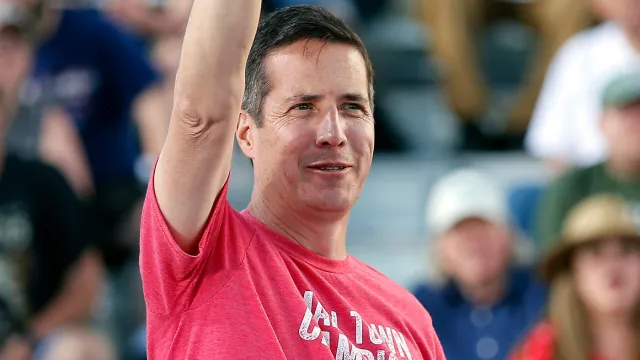
The headline is premature since no polls (yet) show what the title claims. But it's never too early for the liberal media to begin focusing their attacks on a Republican candidate, and tying one to Trump is -- they think -- a winning strategy. It usually is, but not always. Like just two years ago in Ohio, for example.
In 2022 Senate races in North Carolina and Ohio the anointed Democrats were basically unopposed in their primaries and were very well-supported financially; unlike GOP Senate candidates everywhere, who were drastically outspent. The Rats lost those two races anyway, but did (almost) everything possible to win them. In the 2020 Senate elections they cleared the field in Colorado, Georgia twice and North Carolina, were fully united, and picked up 3 of those 4 seats. In 2018 the same applied to Arizona and Nevada and both were successful pickups. Now in 2024 the liberal GOP establishment is, as usual, ramming "moderates" down our throats and marginalizing the supporters of "can't-win" conservatives in West Virginia and Montana and to some extent Ohio, which are the only three states where Republicans have a viable chance of flipping Senate seats from D to R. WV is a sure pickup no matter who the Republicans nominate (they still greatly prefer the squishy old Governor over the young conservative Rep.) and MT and OH are tossups at best. In Ohio, with pro-abortionist/anti-2A state senator Matt Dolan clearly on the left no matter what fakes to the center his campaign tries, and Bernie Moreno supposedly on the right, Secretary of State Frank Larose is in the middle and will be the deciding factor in the GOP Senate primary -- can he take enough votes to win, and if he doesn't quite accomplish that then which of the other two candidates does he steal the most from to deprive them of the win? Does he split the center-right vote and make Dolan the nominee, or does he split the center-left vote and inadvertently help Moreno? Dolan, a la Nikki Haley, will beg for (and get) support from Democrat interlopers voting in the Republican primary; that is a scheme which he also used in 2022. The most recent poll in this race is over a month old and favors Moreno -- but with merely 22% for him, and 44% still undecided. None of the three frontrunners are remotely close to pulling away from the others yet, and that may never happen unless one drops out. Larose is currently coming up way short in the money battle, but even Dolan and Moreno combined have less campaign cash-on-hand than liberal incumbent Democrat Sherrod Brown. Trump endorsed Moreno back in December, a few days before Christmas. Trump's blessing is usually good as gold in a primary (and normally a lead balloon in all but the safest general elections, cherry-picked "winning percentage" aside), and no polls have apparently been taken since that endorsement of Moreno. Bernie ought to get a nice bump in the next one. If or when he becomes the clear favorite however, the media will begin to savage him even harder than the linked article at the top of this commentary does. Tags:
2024
Senate
Ohio
Bernie Moreno for the win!
| |||||||||||||||||||||||||||
| 1/19/2024: [New York] Third District Poll: Democrats with Edge to Pick up Congressional Seat [Emerson] | |||||||||||||||||||||||||||

Photo credit: WABC
On Thursday, Emerson College released numerous 2024 election polls including one for the mid-February special election in New York's 3rd Congressional District. That election was necessitated when freshman Republican George Santos was expelled from Congress last December at the behest of his own party, so as not to serve as a distraction from Republican efforts (to lose?) in November. As if to prove the above statement, national Democrats wasted no time in fundraising or attacking the Republican candidate. It was announced in early January that the Rats had purchased $5.2 million worth of local advertising, and in fact ads supporting Suozzi (and hating Pilip) are saturating the airwaves; in contrast, national Republicans had reserved the paltry sum of $0.2 million in advertising as of January 2. The local liberal media has rolled out the red carpet for Suozzi by offering to schedule and broadcast as many as four rigged debates in his favor. Pilip has astutely declined most of the invitations to those "gotcha" sessions. Recent history: After liberal Democrats had been in control locally in Nassau County for years, Republicans began to claw their way back in 2021. In 2022 they captured all four Long Island congressional districts including the two Democrat-oriented districts in Nassau County (CD-3 is one of those). In 2023 Republicans reclaimed all significant county-level offices on Long Island, and so would appear to have momentum there. Santos was expelled from Congress mainly because his skittish New York colleagues feared he would break that momentum and cause their fluke victories in 2022 to be reversed in 2024. That's very likely to happen anyway and always was likely, Santos notwithstanding. Even if George Santos had never existed in Congress, a GOP bloodbath in New York in 2024 was inevitably in the cards based on the narrow upset outcomes in 2022 in several districts, and a new hyper-partisan Democrat gerrymander which will be implemented before November. Many have suggested that we never should have reached this point, and the GOP should have supported Santos instead of shunning him -- just like the Rats support their sleazebags (such as Senator Menendez) no matter what. They support them unless there's something to be gained by a "loss" like when they jettisoned Al Franken (D-MN) in 2017, knowing he would definitely be replaced by another Democrat. Then the Rats could virtuously claim that all other Democrats in office were squeaky clean while they slandered Republican judge Roy Moore who was running for the Senate in Alabama at the time (and lost). Moore faced similar allegations to Franken. The difference is that the charges against Moore were false. Five years after that election, far too late, Moore won his defamation lawsuit. Comparing the Santos situation to Menendez is apples and oranges. If Menendez goes, the liberal Democrat Governor of New Jersey immediately appoints a liberal Democrat replacement (just like what happened in Minnesota with Franken) and New Jersey then compliantly votes for a Democrat whenever the special election comes around. There is nearly zero risk if the Rats ever do the right thing and throw Menendez into the nearest dumpster. However when Santos left, it opened up a valuable House seat in a district that voted for Biden by 8 points in 2020 (using current district lines), and one where Democrats outnumber Republicans by 11%. There's considerable risk that Santos will be replaced by a Democrat, but the liberal GOP establishment calculated that there was greater risk in allowing Santos to remain. For every Democrat crime that comes to light (rare though such exposure is), the leftists could always say "Oh yeah, but what about Santos???" More polling details: Biden is hideously unpopular in NY-3 (59% disapproval, 26 points under water) and Governor Hochul (66% disapproval) fares even worse. People in this district wouldn't cross the street to spit on her if she were on fire. Actually, that might be fun to see. However, the one politician who is way more unpopular than both of those is Santos (83% unfavorable rating). This election is meant to be a referendum on Santos. Period. The GOP candidate is a good one, and Suozzi probably inspires about as much enthusiasm as Basement Biden does though he does have name recognition, tons of money and lots of hateful (but influential) ads running 24/7. If the current polls are accurate to any degree, instead of an 85% chance of losing this seat, maybe the probability of Republican defeat is down to around 65% now? The media and other liberals insist that the voters in New York's 3rd Congressional District be ashamed of their earlier election of Santos and demand that those voters cleanse their consciences by going for the Democrat this time around and in November as well. We'll see in about a month if they obey those demands. Will a plurality of the voters (however slight that plurality might be) let this election outcome be what the Democrats and the media want? Hopefully not, but probably so. Tags:
U.S. House
2024
New York
Special election
The 'shame' of the Republicans
| |||||||||||||||||||||||||||
| 7/24/2023: Trump's enemies pursue more and more indictments -- to ensure his 2024 nomination [NY Post] | |||||||||||||||||||||||||||

Photo credit: AP/Charlie Neibergall
Rich Lowry, the author of the article, is what passes for a mainstream, establishment "conservative" these days, but he's right on the money with his premise here regarding the 2024 presidential election:
It's beyond obvious that the uniparty puppetmasters want Trump to be the presumptive GOP nominee for as long as possible, even if he doesn't quite make it to the November ballot. This includes their rigging of the opinion polls (ya know, the ones which are always claimed to be total BS except when they tell us what we wish to hear): "Pollz say Trump gonna beat Biden, this time fur shurr herp derp!!1!". The liberal media has willingly and successfully helped Trump neuter any threat from Ron DeSantis, and have helped to enhance Trump's appeal to his base -- and only to that base -- which will sweep him to glorious primary victories but is woefully insufficient by itself to win a general election. All this pumping of the tires gets the base giddy with excitement and makes the crash even more painful when the puppetmasters pull the rug out as close to the last minute as they can manage, sapping all enthusiasm on the right when Trump turns out not to be the nominee and some uninspiring milquetoast is instead. There's no way Trump will support anyone else as the GOP nominee, which means he either runs as an Independent (which ensures a Democrat win) or gets a ton of write-in votes from disgruntled supporters (which ensures a Democrat win). Even if the conspiracy theories don't play out and Trump carries the GOP banner, since he cannot win a national election by getting only the votes of his devout supporters (nobody can), the whole constant accusation, indictment and trial scenario is designed to succeed in peeling off as many undecideds/independents as possible who surely won't vote for a "criminal" for President. Unless that criminal is a Democrat. To summarize, the idea is that whether Trump is a damaged GOP nominee or whether he runs third-party, the end result will be the same. Or so the uniparty desperately hopes. There is one way and perhaps only one way to screw up those plans: And that is for Joe Manchin and/or RFK to pull a "Perot" and mix things up enough that Trump can still win despite getting no more than about 40% of the popular vote in a 3-way race. That's not too far below Trump's upper limit anyway, but with two opponents splitting the anti-Trump vote he may be able to prevail with something along the lines of the outcome in 1992, when Bill Clinton and his lovely wife Bruno won with just 43%. There might be as many folks on the left seeking a better option than Biden as there are on the right who are seeking a better option than Trump. If a third party can pull off significantly more votes from the left than the right, but not be so popular as to actually steal any GOP electoral votes, then Trump has a chance to win. However if a third party looks to be even remotely threatening, Democrats will stop at nothing to abort it. Tags:
Donald Trump
2024
No! Wait! Now we want him OFF the ballot!
| |||||||||||||||||||||||||||
| 2/1/2023: These are the states Americans are moving to [The Hill] | |||||||||||||||||||||||||||

Photo credit: iStock
Nothing unexpected here -- people are moving to the usual destinations (Texas, Florida, the rest of the Sun Belt) and fleeing from pathological liberal areas, especially California which has had net domestic outmigration for three decades now and led the nation again in escapees in 2022. Tags:
Demographics
Voting with their feet
Texas
Californication
| |||||||||||||||||||||||||||
| 11/7/2022: Final 2022 election predictions! [RightDataUSA] | |||||||||||||||||||||||||||
Sorry we've been out of touch for a couple of months (family issues), but here are some realistic predictions for what will happen Tuesday.
Tags:
U.S. House
Senate
2022
Take back the House
But not the Senate
|
